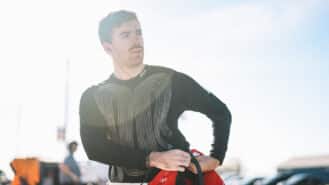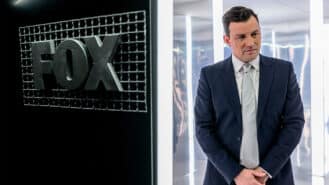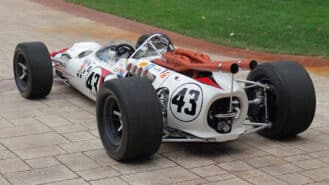
A ‘New Nige’? Foster focused on becoming next British IndyCar star
Louis Foster starts his IndyCar journey this weekend in St Petersburg – can he emulate other British heroes like Nigel Mansell and Dan Wheldon?
Alex Tagliani has qualified on pole for Sunday’s 95th Indianapolis 500. The Canadian narrowly beat 2008 Indy winner Scott Dixon to the top slot, averaging 227.472mph. The 38-year-old has been racing Indy-type cars for 11 years and started his own team, FAZZT Racing, in 2009. Tagliani sold the team in March to Sam Schmidt, a former driver who is running three cars in this year’s 500. Focusing on driving this year, Tagliani set the pace in last week’s rain-shortened practice at Indianapolis before taking pole on Saturday.
Alex Tagliani celebrates his Indy 500 pole
A gold Rolex: that’s the prize these British aces crave when they abandon the winter chill and head to Florida for the Daytona 24 Hours. But what else makes this enduro such an irresistible draw? The Brits are back in town. They’re over here, overjoyed, and ready to run one of the truly great races. They like the weather here too, down on the beach at Daytona. But it’s not the prospect of rays that has drawn them over the pond to the Sunshine State; it’s the race, and a gold Rolex for the winners. The Daytona 24 Hours is one of the toughest challenges, and 2012 was a bit special because it was the 50th anniversary of the ‘Rolex 24’, so named in deference to its horological sponsor. Derek Bell is an old hand now but when he first came here he sensed that Daytona International Speedway was a track that could not be underestimated. He’s won the 24 Hours three times and yet he admits this is not like any other long-distance race. Having won Le Mans five times, Bell is perfectly placed to assess the specific challenges posed by Daytona. “The banking does get your full attention,” says the former World Sportscar Champion. “It’s pretty steep and in traffic the slower GT cars can be three abreast in front of you. But it’s not the banking that makes the demands – a good driver will soon have that sorted – it’s the constant traffic and tight confines of the infield that make the race such a challenge.” As this always beguiling event reaches its half-century, ‘our boys’ Dario Franchitti, Allan McNish, Ryan Dalziel, Oliver Gavin, Justin Wilson and Richard Westbrook gave me their impressions of Daytona. Allan McNish Riley-Ford. Finished: 2nd “Let me tell you, I was pleased Ryan got the pole – it meant our car was good for the race. It was great to be in the same car as Ryan. It’s his home turf now [Dalziel won the race in 2010], and he knows the team and the car, so he gave me some pointers about the cars because they are specific little beasts. "You never get a traffic-free lap here so you have to be tidy, make the best of the yellows, and be there in the last half an hour when the order is usually decided. Up at the front it’s pretty close between the Daytona Prototypes so you must not let anyone get too far away from you in the traffic. It can be frustrating, there can be a wee bit of luck involved, but I love this race all the same. “Physically it’s not as tough as Le Mans where we run long stints, and where the cornering speeds are so high, with a lot of g-force. At Daytona there’s not much time to relax, no respite from the traffic, so that demands a lot of concentration. You’re on it all the time, which is why most of the teams run four drivers. There’s no places where you can take a breather. “In 1982 I came here on holiday with my parents and watched the Daytona 200 bike race from the top of the banking. That looked a bit daunting, and there’s no question the place still has a lot of presence that tickles you, especially at night. Maybe the cars have less kudos now compared with the great days when Ferrari and Ford were here with the P4 and the GT40, but the new format is still exciting and it draws a very good line-up of drivers. It’s still a big race even though it may no longer be a ‘must do’ event for all the big names.” Ryan Dalziel Riley-Ford. Finished: 2nd “When I first came to Daytona I was still an open-wheeler racer and I had a tour of the place. Coming in through the tunnel it’s an incredible sight, like a bull ring, and quite intimidating at first. Now I’m used to it and you just have to be aware that you’re mixing it with drivers who may have come from single-seaters and never raced here before. “At Daytona you need a car with good balance between aero and mechanical grip and there’s a lot of time to be made in the infield, which is very technical and you need a perfect aero trim on the car. This time I was sharing with my countryman Allan McNish, which spurred me on a little bit – he’s still at the peak of his game, one of the best guys out there, and I can still learn things from him. But I tell you, having put the car on pole for the race, I was rubbing that in, and he’s gonna be hearing about it for a long time…”
Dario Franchitti Riley-BMW. Finished: 4th “For me, the Daytona 24 is a chance to race against people I’ve admired for years, people I’ve never raced against before who come from all over the world, and guys I raced against when I was a kid. You can say what you like about the equivalency formula and all that stuff, but at the end of the day we get out there and give it hell for 24 hours. And it’s a lot of fun. “I’m lucky to be driving with what I believe is the best team in the business and it does mean a lot to win this race [Franchitti won at Daytona in 2008]. It’s been frustrating this year, with Ford engines so strong on the straights, but the race still means a lot to me. “People talk about the banking. First time out there it can be daunting – but any driver worth their salt shouldn’t be fazed by it after five or six laps out there. A lot of the drivers who come for this race have a huge amount of experience in sports cars, but I’ve been impressed by young Felipe Nasr who has no experience and is obviously very talented. It gets very busy on the track and you’re flat out all the time, so in a three-hour stint, for sure you have to stay focused. “The problem with the equivalency formula we have now is that people tend to sand-bag beforehand, so it’s only in the race you find out who’s been sand-bagging. Clearly the Fords had something in reserve this year. It’s frustrating – but hey, if I had an advantage I’d be quite happy with the formula.” Oliver Gavin Corvette Daytona. Finished: 8th “There is no other track like Daytona. When you first get up on the banking you’re struggling to see round the corner, you keep wanting to look up, and look further round the corner. But you can’t, so to have that limit on your vision is a bit daunting at first, and it takes a few laps to get your head around that. You need to be prepared for any kind of drama when you’re up on the banking. “It took me about 30 laps of the place to feel really dialled in, to know where the grip is, where the bumps are, where to take a higher or lower line. It’s been re-surfaced now so it’s a bit easier, and a low line is the fastest, shortest line. The Daytona specialists who’ve done thousands of laps here, they know every little bump, every patch of grip, but the new surface has taken some of that skill away. “The place means a lot to me, it’s where all the great teams and drivers have come, and won, and you want to be a part of that great history. It’s one of the world’s toughest races, right up there with Le Mans, and it’s at the start of the season so you have to be prepared. For Le Mans there’s months of preparation but here, in January, you’re not warming up, you’re going straight into a 24-hour race, so you have to be ready. “What wins this race is the ability to stay out of trouble, to deal with the traffic, and not to collide with a slower GT car. If you have a clean race, you’re going to be in the top three on Sunday, and that means having a car that you can weave in and out of the traffic, a car with good, solid brakes, because there’s guys out there who’ve never driven in the dark, never seen the track before. You gotta remember that a few of them are so bamboozled by just driving the car they don’t always focus on everything else that’s going on around them. So to win, you need to be smart and careful in traffic and have a good strategy over the distance.” Richard Westbrook Corvette Daytona. Finished: 8th “Daytona 2007 was my first ever endurance race. It’s a hell of a place, and has a unique atmosphere being in January, right after the off-season, with new cars and drivers. It can be a bit daunting when you first get out there but you learn that the faster you go round the banking, the better it feels. “Going slowly behind the pace car on the banking there’s no g-force pushing you into the seat, and it feels like you’re going to fall out. That’s when you feel how steep it is. First time here I made the mistake of walking the track and that freaked me out, made me a bit nervous, so you just need to get out there and get up to speed. You need to relax, just let go, and let the angle of the banking do the work. “Threading your way through the GT cars is like a slalom – it’s very busy out there – so if you don’t hit one you’re going to be right up there. You have to use your head. The darkness is no problem because the track is so well lit, the dark is not that dark. “I think it’s tougher than Le Mans because there are no really long straights, and you have blind spots in your mirrors in some places, so you get no respite. It’s one of the classics, up there with the greatest races, and I love it. We should see more Brits, more Europeans here, then it would be even better known back there. This is a big one to win.” Justin Wilson Riley-Ford. Finished: 1st “The Rolex 24 is one of the big prizes in motor racing. The race carries a lot of prestige, and a lot of famous drivers have won at Daytona, which makes it a big one to win. It’s certainly one I wanted to win. It means a lot to me to have my name up there, to be part of a pretty elite group of drivers. On top of that there’s a nice gold Rolex watch too… “The race itself is a lot of fun, although it can be tough in the middle of the night. It’s a great way to start the season. You can hang out with friends from throughout your career – and there’s no other racing at this time of year. “The track is very, very technical, a bit daunting at first, but the banking is actually the easy part. It’s the infield where you make the time. You need to be very precise with the car but at the same time you have to hustle it along. The technique is not as simple as it looks. And the track is constantly changing; the grip levels and the optimal lines shift all the time, depending on where people are running and what stage of the race you’ve reached. “You never truly feel that you’ve completely understood where this place is at – and then there’s the traffic. We start with as many cars as Le Mans and yet this is only a three and a half mile circuit – early on it’s just chaos. “It’s a bit like indoor karting – you’re coming up on people who hardly ever race, and in a prototype you’re coming up on them so fast. You’re in and out of them so quickly. It’s a little bit crazy, like driving flat out on a busy motorway; you need to be constantly aware, pick your moments to pass, and not lose too much time in the process. The racing is hard – you run flat out and the cars can take it, which means there’s very little left to go any quicker if you need to. You just keep the pace going and hope you’re still there at the end to pick up the win. “The secret of Daytona is all about being as fast as possible without making a single mistake. You push right to the limit, but not once in those 24 hours can you go over that limit. It’s easy to make a small error but you simply cannot afford to damage the car. It’s pretty tough – the cars are quite heavy and it’s easy to make a mistake. You need to be constantly careful while at the same time racing as hard as you can.” Rob WiddowsA Quebec native, Tagliani raced Formula Atlantics for three years before graduating to CART in 2000 with Jerry Forsythe’s Player’s team. He joined Paul Gentilozzi’s Rocketsports team in ’03, before scoring his first and only Champ Car victory at Elkhart Lake the following season. He drove for Derrick Walker’s Team Australia in 2005-06 before rejoining Rocketsports in ’07 and then racing stock cars in Canada in ‘08. The following year Tagliani ran a half season in the IRL before starting his own team.
A pair of Brits, Rob Edwards and Allan McDonald, runs Schmidt’s team. Team manager Edwards worked for Walker for many years while chief engineer McDonald most recently worked for Michael Andretti’s team. “I’m really thankful for the amount of work this crew has put in,” said Tagliani. “I’m going to pinch myself tonight. It’s a team effort, good sponsorship and an amazing crew that believes in the team and me. I’m really happy for Sam. He deserves it. He’s a great leader and hopefully there’s more results like this to come.”

Both Dixon and Dario Franchitti in Chip Ganassi’s cars ran out of fuel on their four-lap qualifying runs. Dixon hit trouble coming off Turn 4 on his last lap but was able to qualify second. “It’s frustrating,” he said. “I think it would have been damn close. But the car’s strong and hopefully we can have a clean day next weekend and maybe get another Borg-Warner Trophy.”
Franchitti looked like challenging Tagliani for pole but ran out of fuel going into his fourth and last qualifying lap. The Scot will start the 500 from ninth place. “The car was quite good and we were looking good,” he said. “I could see more rpm and speed coming out of Turn 2 and the balance was getting better, but it just ran out starting the last lap. It bobbled a bit before the yard of bricks and then it went completely going into Turn 1. Even the best team in the business make mistakes sometimes.”
Oriol Servia did an excellent job to qualify on the outside of the front row in Newman/Haas Racing’s lead car. Championship leader Will Power qualified in the middle of row two between Townsend Bell and 2005 Indy winner Dan Wheldon. Power’s Penske team-mates Hélio Castroneves and Ryan Briscoe both qualified poorly. Three-time winner Castroneves will start from 16th on the grid and Briscoe in 27th. This is the first time since 2004 that Penske has not had a car on the front row.

In even more trouble was Michael Andretti’s team. Michael’s cousin John was the team’s best qualifier among its five entries, in 17th, while Long Beach winner Mike Conway and Ryan Hunter-Reay failed to make the field. Hunter-Reay was bumped at the last moment by team-mate Marco Andretti.

Louis Foster starts his IndyCar journey this weekend in St Petersburg – can he emulate other British heroes like Nigel Mansell and Dan Wheldon?

Myles Rowe has rocketed through IndyCar's junior ladder with a story like no other – he tells James Elson why this upcoming year is more important than ever

Drive to Survive star Will Buxton has made the jump across the Atlantic to front Fox's new IndyCar coverage – he explained to James Elson why he thinks the championship is the most exciting series out there

Jackie Stewart's Lola-Ford IndyCar that failed laps from victory in the 1966 Indy 500 was the star lot in a 16-car auction, selling for $715,000